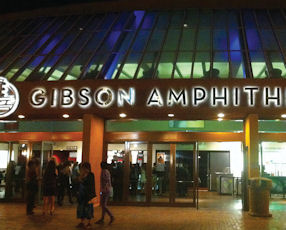About 500 stage hands and other workers stand to lose their jobs with the previously announced closure of the Gibson Amphitheatre, according to a layoff notice filed with the state. The 6,000-seat Gibson, which opened in 1972 as an outdoor theater on the grounds of Universal Studios, is being demolished to make room for the planned “Wizarding World of Harry Potter” theme park ride. Owned by the House of Blues Concerts, a subsidiary of Beverly Hills-based Live Nation Entertainment Inc., the Gibson is the largest performance space in the Valley. Regional competition among venues has increased in recent years with the 2007 opening of the 7,100-seat Nokia Theatre, part of the L.A. Live complex in downtown Los Angeles, developed by the Anschutz Entertainment Group. Also in 2007, the Pantages Theater in Hollywood re-opened after a lengthy renovation with 2,700 seats. Once the Gibson closes this fall, the remaining Valley venues will be the 1,800-seat Bank of America Performing Arts Center owned and operated by the City of Thousand Oaks, and the Valley Performing Arts Center on the campus of California State University Northridge. The $125 million university center consists of a 1,700 seat main concert hall and a 178-seat black box theatre. It opened in January 2011 and is the newest venue in Los Angeles. The closure highlights how the increasing number of area venues coupled with severe pressure to generate maximum revenue in the music industry have put the squeeze on concert halls. Hal Abramson, a concert promoter and consultant in Rockville, Md., said there are two economic factors at play in the decision to close the Gibson. One is that Comcast Corp.’s NBCUniversal division, which owns the land, realized it could achieve a better use and return on the property than a concert venue. And the other is that the size of the Gibson is not big enough to attract the top-name acts. With 6,000 seats and an average ticket price of, say, $50 that would bring in $300,000 gross per performance, of which about half that amount would to pay the performers. “These bands have priced themselves into the stratosphere,” Abramson said. “If you do not have 18,000 or 20,000 seats, you are not going to put that act in that facility.” Headliners In nearby Hollywood, recent experience shows the difficulty in finding stable income in the venue sector. In March 2012, concert promoter Goldenvoice, a division of AEG, took over the lease of the Fonda Theatre in Hollywood after the previous operator defaulted on the lease. After the bankruptcy of Eastman Kodak Co. the company dropped its name from the Kodak Theatre, home of the Academy Awards. Audio technology firm Dolby Laboratories Inc. took over the naming rights of the 3,300-seat venue. The Dolby was to be the long-term home for “Iris,” a production of Cirque du Soleil but the show closed after less than 18 months due to poor ticket sales. The theater will now host touring acts and headlining performers. The Gibson, though, has a long and storied history since opening more than 40 years ago. Some of the biggest names in popular music have played its stage. It has also been the site of awards shows and live radio broadcasts. Bob Dylan, Stevie Wonder, Elton John, Tom Petty, Paul Simon, and Johnny Cash are just a few of the performers to headline the venue. So did The Beach Boys, The Eagles, and Pearl Jam and the Grateful Dead. Frank Sinatra was the first performer when the theater re-opened as an enclosed space. “The list of musicians that have played here is simply staggering,” Bret Gallagher, President of North American Concerts, Southern California/Las Vegas for Live Nation, said in a prepared statement when the closure was announced. “We are honored to have been a part of its remarkable story.” The Gibson has also been host to five U.S. presidents who have spoken there, including Barack Obama. Employee impact The employees who will lose their jobs at the Gibson include 387 stagehands, 29 ushers, 15 ticket agents, six riggers, and a host of other jobs, according to Worker Adjustment and Retraining Notification, or WARN notice, filed with the state Employee Development Department. Many of the positions are represented by one of three International Alliance of Theatrical Stage Employees locals based in the San Fernando Valley. Mark Bauer, the acting business manager for Burbank-based IATSE Local 33, which represents stagehands, anticipated that the stagehands who do work at the Gibson will be absorbed into the work force. They already find work at other theaters when the Gibson is not booked with shows, he added. “They will just move to another venue somewhere,” Bauer said. Stagehands set up the platforms, staging, and the rigging that sounds and lighting systems hang of from for live stage shows. Among the venues Local No. 33 supplies stagehands for are the Dolby Theatre and Hollywood Bowl in Hollywood, the Dorothy Chandler Pavilion, Ahmanson Theatre, Mark Taper Forum, Staples Centre, and Nokia Theatre in downtown, and the Home Depot Center in Carson. IATSE Local No. 857 represents ticket sellers and the treasurers who supervise ticket booths. There is a possibility but it’s not a given that Gibson ticket sellers will find work immediately because the venues of the local contracts with are fully staffed for the summer, said Sergio Medina, the business agent 857. “If they were to find other work it would not be until the end the summer season,” Medina said. Live Nation announced in April that it was closing the Gibson in September with the end of a lease agreement on the venue. Shows already booked for the venue after it closes will be moved to other locations.
